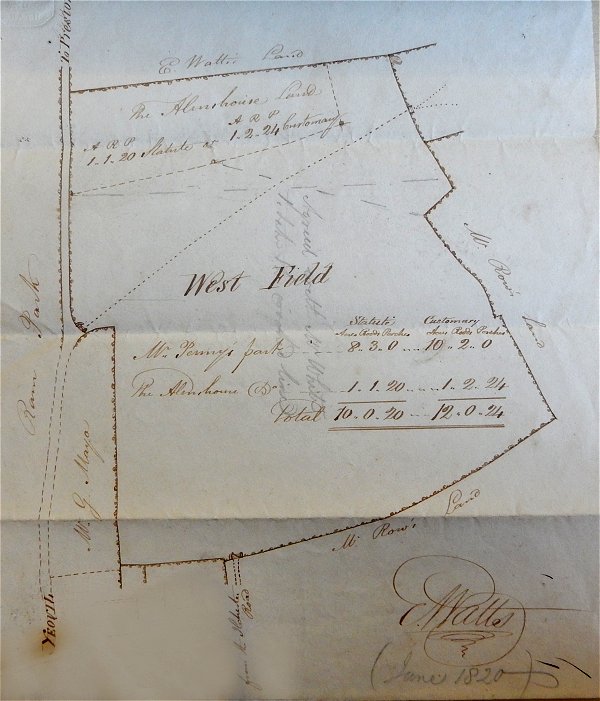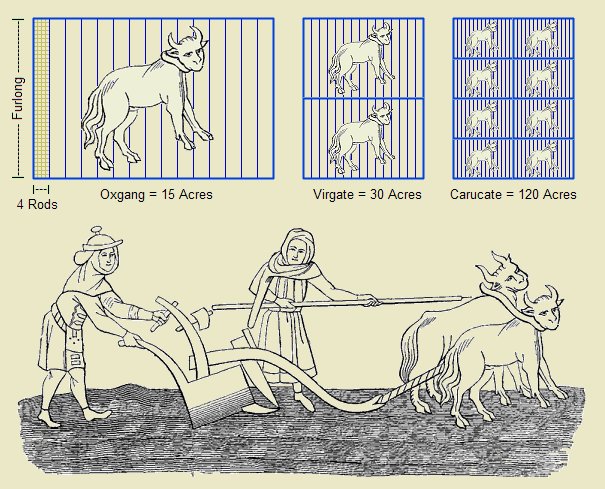Land Measurement (Historic)
Land Measurement (Historic)
A note on measuring land areas
Throughout this website, when dealing with parcels of land, land transactions, and the like, measurements of area are invariably given in acres, roods (not rods) and square perches - for instance the area of a field might be given as 1a 3r 14p - meaning one acre, three roods and fourteen square perches.
There are 40 square perches to the rood, and four roods to the acre.
Acre
One acre equals 0.0015625
square miles, 4,840 square yards, 43,560 square feet or
about 4,047 square metres (0.405 hectare). Originally,
an acre was understood as a selion (a medieval strip of land) sized at
forty perches (660 feet or 1 furlong) long and four
perches (66 feet wide); this may have also been understood
as an approximation of the amount of land a yoke of oxen
could plough in one day.
Rood
A rood is a unit of area,
equal to one quarter of an acre. A rectangular area with
edges of one furlong (i.e. 10 chains, or 40 rods) and
one rod wide is one rood, as is an area
consisting of 40 perches (square rods). The rood was an
important measure in surveying on account of its easy
conversion to acres.
Perch
As a unit of area, a
square
perch (the perch is also a unit of length being standardized to equal 16½
feet, or 5½ yards) is equal to a square rod, 30¼
square yards (25.29 square metres) or 0.00625 acre, or
1/160 acre. 40 square perches, or square rods, equals one rood.
Note - perches and rods are units of length, square perches and square rods are units of area.
Customary Measurements versus Statute Measurements
Many fields have an acreage expressed in their field name which is often different to the actual acreage as expressed in the Tithe Apportionment - for example all eight fields of Preston Lower Farm whose names suggested an acreage such as Three Acre Mead, Four Acres, etc., were actually less than their names would suggest. However this is due to the use of 'Statute' measurements in the Apportionment which were actually smaller than local 'Customary' measurements, both of which are noted on the 1820 plan of West Field, shown below. It should be noted that the actual dimensions of 'customary' measurements varied across the country.
It should also be noted that prior to a time around the 1820s land valuers tended to follow a mensuration of land area which related solely to the useable land and excluded the area taken up by hedges, banks and ditches. This resulted in deficiencies in earlier mensuration of between 5 and 10 per cent. The area occupied by hedges, banks and ditches tended to be included in land mensuration from around the 1830s.
As noted by Sir Robert de Zouche Hall "The relevance of these varying standards to a study of changes in farm rents will be apparent. For example, a field let at 40/- an acre customary measure for the land enclosed by hedges would require, to bring the same return to the owner, about 48/- an acre on the same basis by statute measure, but the figure would only rise to about 45/- if the later basis included also the hedges and ditches."

A plan by Edward Bullock Watts of 1820 showing West Field - north is to the right and Preston Road runs along the left edge of the plan. This plan was produced in evidence as proof of ownership of the land at the time it was bought by the Corporation for the purpose of creating the cemetery. Its importance however is that it shows that two systems of land measurement, ostensibly using the same units, were being used concurrently.
However....
In earlier medieval times other units of measurement were common -
The rod is a historical unit of length equal to 5½ yards. It may have originated from the typical length of a mediaeval ox-goad. There are 4 rods in one chain.
The furlong (meaning furrow length) was the distance a team of oxen could plough without resting. This was standardised to be exactly 40 rods or 10 chains.
An oxgang was the amount of land tillable by one ox in a ploughing season. This could vary from village to village, but was typically around 15 acres.
A virgate was the amount of land tillable by two oxen in a ploughing season.
A carucate was the amount of land tillable by a team of eight oxen in a ploughing season. This was equal to 8 oxgangs or 4 virgates
